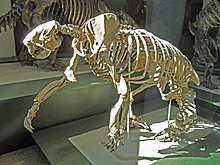
Back Megalonyx Catalan Megalonyx German Megalonyx Spanish بزرگپنجه Persian Megalonyx Finnish מגלוניקס HE Megalonyx Italian Мегалоникс Kirghiz Megalonyx Dutch Megalonyx Portuguese
| Megalonyx | |
|---|---|

| |
| M. wheatleyi skeleton in AMNH | |
| Scientific classification | |
| Domain: | Eukaryota |
| Kingdom: | Animalia |
| Phylum: | Chordata |
| Class: | Mammalia |
| Order: | Pilosa |
| Family: | †Megalonychidae |
| Subfamily: | †Megalonychinae |
| Genus: | †Megalonyx Jefferson, 1799[1] |
| Type species | |
| †Megatherium jeffersonii[1] Desmarest, 1822
| |
| Species | |
Megalonyx (Greek, "great-claw") is an extinct genus of ground sloths of the family Megalonychidae, native to North America. It evolved during the Pliocene Epoch and became extinct during at the end of the Late Pleistocene, living from ~5 million to ~13,000 years ago.[3] The type species, M. jeffersonii (also called Jefferson's ground sloth), the youngest and largest known species, measured about 3 meters (9.8 ft) in length and weighed up to 1,000 kilograms (2,200 lb).[4]
Megalonyx is suggested to have descended from Pliometanastes, a genus of ground sloth that had arrived in North America during the Late Miocene around 9 million years ago, prior to the main phase of the Great American Interchange. Megalonyx had the widest distribution of any North American ground sloth, having a range encompassing most of the contiguous United States, extending as far north as Alaska during warm periods.
Megalonyx is notable for having been originally described by future U.S. President Thomas Jefferson in 1799 based on remains found in West Virginia; the species M. jeffersonii was described later, named in honor of him.[1]
Megalonyx became extinct as part of Late Pleistocene extinctions, simultaneously with all other mainland ground sloths and most other large mammals native to the Americas. These extinctions followed the arrival of humans in the Americas, and there is evidence that humans interacted with Megalonyx, including butchering its remains shortly prior to its extinction.
- ^ a b c Babcock, Loren E. (18 March 2024). "Nomenclatural history of Megalonyx Jefferson, 1799 (Mammalia, Xenarthra, Pilosa, Megalonychidae)". ZooKeys (1195): 297–308. Bibcode:2024ZooK.1195..297B. doi:10.3897/zookeys.1195.117999. ISSN 1313-2970. PMC 10964019. PMID 38532771.
- ^ Megalonyx obtusidens at Fossilworks.org
- ^ McDonald, H. Gregory; Stafford, Thomas W.; Gnidovec, Dale M. (March 2015). "Youngest Radiocarbon Age for Jefferson's Ground Sloth, Megalonyx Jeffersonii (Xenarthra, Megalonychidae)". Quaternary Research. 83 (2): 355–359. Bibcode:2015QuRes..83..355G. doi:10.1016/j.yqres.2014.11.006. S2CID 129016865. Retrieved 2021-05-23.
- ^ "Sandiegozoo". Archived from the original on 2015-02-14. Retrieved 2012-05-30.
© MMXXIII Rich X Search. We shall prevail. All rights reserved. Rich X Search